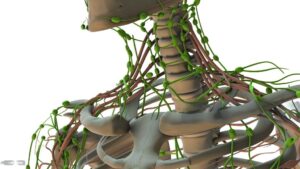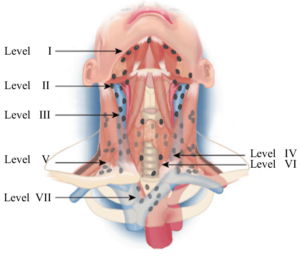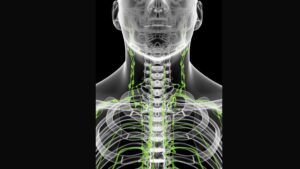The lymphatic system plays a crucial role in maintaining the body’s immune defense by filtering pathogens and participating in the fluid balance. Within this intricate system, the 7 levels of lymph nodes in the neck stand out for their importance in both health and disease. This article delves into the anatomy, functions, and clinical significance of these nodes, offering insights into their role in diagnosing and treating diseases, particularly cancer. Our journey through understanding the 7 levels of lymph nodes in the neck begins with an exploration of what lymph nodes are and why they are pivotal in the medical field.
Table of Contents
Toggle- Lymph nodes: What Are They and Why Are They Important?
- Deep Dive into the 7 Levels of Lymph Nodes in the Neck
- Clinical Importance of the 7 Levels of Lymph Nodes in the Neck
- Imaging and Diagnosis
- Surgical Treatment and Considerations
- FAQs About the 7 Levels of Lymph Nodes in the Neck
- Conclusion
- References and Further Reading
- Call to Action
Lymph nodes: What Are They and Why Are They Important?

Lymph nodes are small, bean-shaped structures that play a critical role in the body’s immune response. As part of the lymphatic system, they filter lymph—a clear fluid that circulates throughout the body, carrying cells that help fight infection and disease. The 7 levels of lymph nodes in the neck are particularly significant due to their location where they filter substances picked up from the head and neck, areas frequently exposed to pathogens.
The neck region’s lymph nodes are pivotal in diagnosing and treating diseases, especially cancers. Their involvement can provide vital clues about the disease’s nature, stage, and spread. For example, the presence of cancerous cells in the lymph nodes often indicates metastasis, where cancer has spread from its original site. This makes the 7 levels of lymph nodes in the neck a focal point in cancer diagnosis and treatment planning, highlighting their importance in the medical field.
Deep Dive into the 7 Levels of Lymph Nodes in the Neck

Level I: Submental and Submandibular Nodes
- Description and Anatomical Position: Located beneath the jaw, Level I nodes are divided into submental (under the chin) and submandibular (under the jawline) groups.
- Common Diseases Affecting Level I Nodes: These nodes are often involved in infections and cancers of the oral cavity, reflecting their role in filtering lymph from these areas.
Level II: Upper Jugular Nodes
- Description: Situated along the upper portion of the internal jugular vein, including sublevels IIa (anterior) and IIb (posterior).
- Key Functions and Clinical Significance: Critical in draining lymph from the pharynx, palatine tonsil, and oral cavity, Level II nodes are frequently assessed for head and neck cancers.
Level III: Middle Jugular Nodes
- Description and Anatomical Landmarks: Found along the middle third of the internal jugular vein, these nodes are key in lymphatic drainage from the pharynx and oral cavity.
- Diseases Commonly Affecting Level III Nodes: Their involvement is particularly noted in cancers of the throat and mouth, serving as indicators of disease spread.
Level IV: Lower Jugular Nodes
- Detailed Description and Importance: Located along the lower third of the internal jugular vein, these nodes drain parts of the neck, thyroid, and esophagus.
- Role in Cancer Spread and Treatment: Level IV’s nodes are crucial in assessing the spread of cancers within the neck and are a focus during surgical interventions.
Level V: Posterior Triangle Nodes
- Explanation of Sublevels Va and Vb: This level encompasses nodes along the spinal accessory nerve and transverse cervical artery, divided into Va (above the muscle) and Vb (below the muscle).
- Clinical Relevance in Disease Diagnosis: They are essential in diagnosing lymphomas and metastases from head and neck cancers.
Level VI: Anterior Compartment Nodes
- Description and Diseases Affecting Level VI: These nodes, located between the hyoid bone and the sternum, are pivotal in thyroid cancer diagnoses.
- Importance in Thyroid Cancers: Given their location, Level VI nodes are directly involved in the spread of thyroid and parathyroid cancers.
Level VII: Additional Nodes (Superior Mediastinal Nodes)
- Explanation of Level VII’s Role and Location: Extending into the chest, these nodes offer insights into cancers that have spread beyond the neck.
- Its Significance in Advanced Cancer Staging: Level VII nodes are evaluated for thoracic cancers and metastases, underscoring their role in advanced disease management.
Understanding the 7 levels of lymph nodes in the neck is essential for diagnosing and treating various conditions, especially cancers affecting the head, neck, and upper chest. Each level’s specific anatomical location and drainage patterns determine its significance in the spread and staging of cancers, guiding therapeutic decisions.
Clinical Importance of the 7 Levels of Lymph Nodes in the Neck

The 7 levels of lymph nodes in the neck play a pivotal role in the clinical assessment and management of various diseases, particularly cancers. Their examination and analysis provide essential information for staging, treatment planning, and prognosis. Here’s how their clinical relevance unfolds:
- Cancer Staging: The involvement of specific lymph node levels can significantly influence cancer staging. For example, the presence of metastatic cancer cells in these nodes often indicates a more advanced stage of disease, necessitating aggressive treatment strategies.
- Head and Neck Cancers: The 7 levels of lymph nodes in the neck are critical in the context of head and neck cancers. Their assessment helps determine the primary site of the cancer, its spread, and the most effective treatment modalities.
- Surgical Planning and Prognosis: Understanding which lymph node levels are affected guides surgeons in planning the extent of neck dissection required during surgery. This strategic approach aims to remove cancerous nodes while preserving as much healthy tissue as possible, thus minimizing complications and improving functional outcomes.
The 7 levels of lymph nodes in the neck serve as a roadmap for clinicians, directing them through the complexities of diagnosis, staging, and treatment of cancers and other diseases affecting the head and neck region. Their importance in clinical decision-making cannot be overstated, underscoring the need for thorough knowledge and careful examination of these lymphatic structures.
Imaging and Diagnosis
Accurate imaging and diagnosis of the 7 levels of lymph nodes in the neck are crucial for effective treatment planning, particularly in cases of cancer. Several imaging techniques are commonly used to evaluate these nodes:
- Computed Tomography (CT) Scans: Provide detailed cross-sectional images of the neck, highlighting lymph node size, shape, and potential abnormalities.
- Magnetic Resonance Imaging (MRI): Offers high-resolution images, particularly useful for evaluating soft tissue contrast and detecting subtle differences in tissue composition.
- Ultrasound: Utilized for its real-time imaging capabilities, allowing for the assessment of lymph node texture and the presence of suspicious features that may indicate malignancy.
Each of these imaging modalities has its strengths and considerations:
- CT Scans are widely available and provide a quick overview, making them a standard first step in the assessment. However, they involve radiation exposure.
- MRI provides superior soft tissue contrast without radiation exposure, making it valuable for detailed evaluations. Its use may be limited by availability and higher costs.
- Ultrasound is non-invasive and cost-effective, offering the advantage of needle guidance for biopsy procedures. Its effectiveness, however, is highly operator-dependent.
Challenges in diagnosing diseases based on lymph node involvement include distinguishing between benign (e.g., reactive) and malignant lymph node enlargement. Factors such as lymph node size, shape, and internal structure are considered, along with patient history and physical examination findings.
The use of these imaging techniques, in conjunction with fine-needle aspiration or biopsy when necessary, enables precise characterization of the 7 levels of lymph nodes in the neck. This approach facilitates accurate disease staging, which is critical for determining the most appropriate treatment strategy.
Surgical Treatment and Considerations
The surgical approach to treating diseases affecting the 7 levels of lymph nodes in the neck is meticulously planned based on the lymph node levels involved and the underlying condition. Key considerations include:
- Type of Neck Dissection: Determined by the extent of lymph node involvement and the primary disease site. Types include:
- Radical neck dissection: Removal of all tissue from the jawbone to the collarbone on one side of the neck, including the sternocleidomastoid muscle, internal jugular vein, and spinal accessory nerve.
- Modified radical neck dissection: Similar to radical, but sparing one or more non-lymphatic structures (e.g., the spinal accessory nerve).
- Selective neck dissection: Only the lymph nodes at risk of containing cancer are removed, preserving as many structures as possible.
- Comprehensive neck dissection: Involves the removal of lymph nodes from multiple levels, often used in cases where the disease has spread widely within the neck.
- Decision-making for Surgery: Based on factors such as the primary tumor’s location, the extent of lymph node involvement, patient health status, and the potential impact on quality of life. The goal is to achieve the best balance between effectively removing the disease and preserving function.
- Post-surgical Care and Monitoring: Involves regular follow-ups to monitor for recurrence, manage any complications, and support the patient’s recovery. Rehabilitation services, including physical therapy and speech therapy, may be necessary to help restore function and quality of life.
The surgical treatment of diseases involving the 7 levels of lymph nodes in the neck requires a comprehensive understanding of the anatomy, disease process, and the potential impact on the patient. Surgeons carefully consider which lymph node levels to target, aiming to remove diseased tissue while minimizing harm to healthy structures, thus preserving function and enhancing recovery.
FAQs About the 7 Levels of Lymph Nodes in the Neck
- What is the significance of the “levels” in lymph node classification?
- The classification into levels helps healthcare professionals identify and communicate the specific areas of lymph node involvement, especially in cancer diagnosis and treatment.
- Can swollen lymph nodes always indicate cancer?
- No, lymph nodes can swell due to a variety of reasons, including infections and inflammatory conditions. Only a medical evaluation, including imaging and possibly a biopsy, can determine the cause of lymph node swelling.
- How are the 7 levels of lymph nodes in the neck examined?
- Physical examination, imaging techniques (such as CT, MRI, and ultrasound), and biopsy procedures are used to evaluate these lymph nodes.
- What role do these lymph nodes play in cancer spread?
- These lymph nodes can act as a pathway for cancer cells to spread from the primary site to other parts of the body. Their involvement is a critical factor in cancer staging and treatment planning.
- Is surgery the only treatment for issues related to the 7 levels of lymph nodes in the neck?
- Although it is a prevalent treatment, surgery is not the sole choice. The choice of treatment depends on the specific condition, including cancer, infections, or other diseases. In certain cases, targeted therapy, chemotherapy, or radiation therapy may also be used as a kind of treatment.
- What are the risks of lymph node surgery in the neck?
- Potential risks include damage to surrounding nerves, blood vessels, and structures, leading to complications such as difficulty swallowing, moving the neck, or changes in voice. However, the surgical technique aims to minimize these risks.
Understanding the 7 levels of lymph nodes in the neck and their clinical significance is essential for both healthcare professionals and patients navigating diagnoses and treatment options for related conditions.
Conclusion

The 7 levels of lymph nodes in the neck play an indispensable role in the lymphatic and immune systems, particularly in the context of diagnosing and treating diseases like cancer. A deep understanding of these lymph nodes’ anatomy, functions, and clinical significance is crucial for healthcare professionals involved in the care of patients with head and neck conditions. This guide has explored the intricacies of the lymph nodes in the neck, highlighting their importance in medical practice.
References and Further Reading
For those interested in delving deeper into the topic, consider exploring the following types of resources:
- Academic journals and textbooks on head and neck anatomy and oncology.
- Clinical guidelines on the management of lymph node metastases in head and neck cancer.
- Online medical resources and databases for the latest research and treatment advances.
Call to Action
We encourage readers to share this comprehensive guide with others who might benefit from a detailed understanding of the 7 levels of lymph nodes in the neck. Healthcare professionals, students, and anyone interested in medical science can gain valuable insights from this information. If you have questions, comments, or wish to discuss further, please feel free to leave a comment below or engage with medical communities online.
Thank you for joining us on this educational journey through the anatomy and significance of the lymph nodes in the neck. Your proactive interest in health and medicine is a step towards better healthcare outcomes for all.
SEE ALSO:
-
7 Important Insights: Is Croup Contagious? Understand the Risks & Protections
-
The L612 Pill (Loratadine 10 mg): Essential Insights for Effective Allergy Relief
-
5 Essential Tips for Popping Hidden Tonsil Stones: A Guide to Relief and Prevention
-
Say Goodbye to Sciatic Nerve Pain in Just 10 Minutes With This Natural Method: A Step-by-Step Guide
-
Essential Digestive Supplements: Transform Your Gut Health Today!
